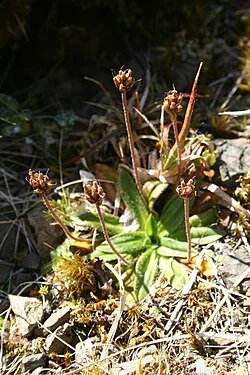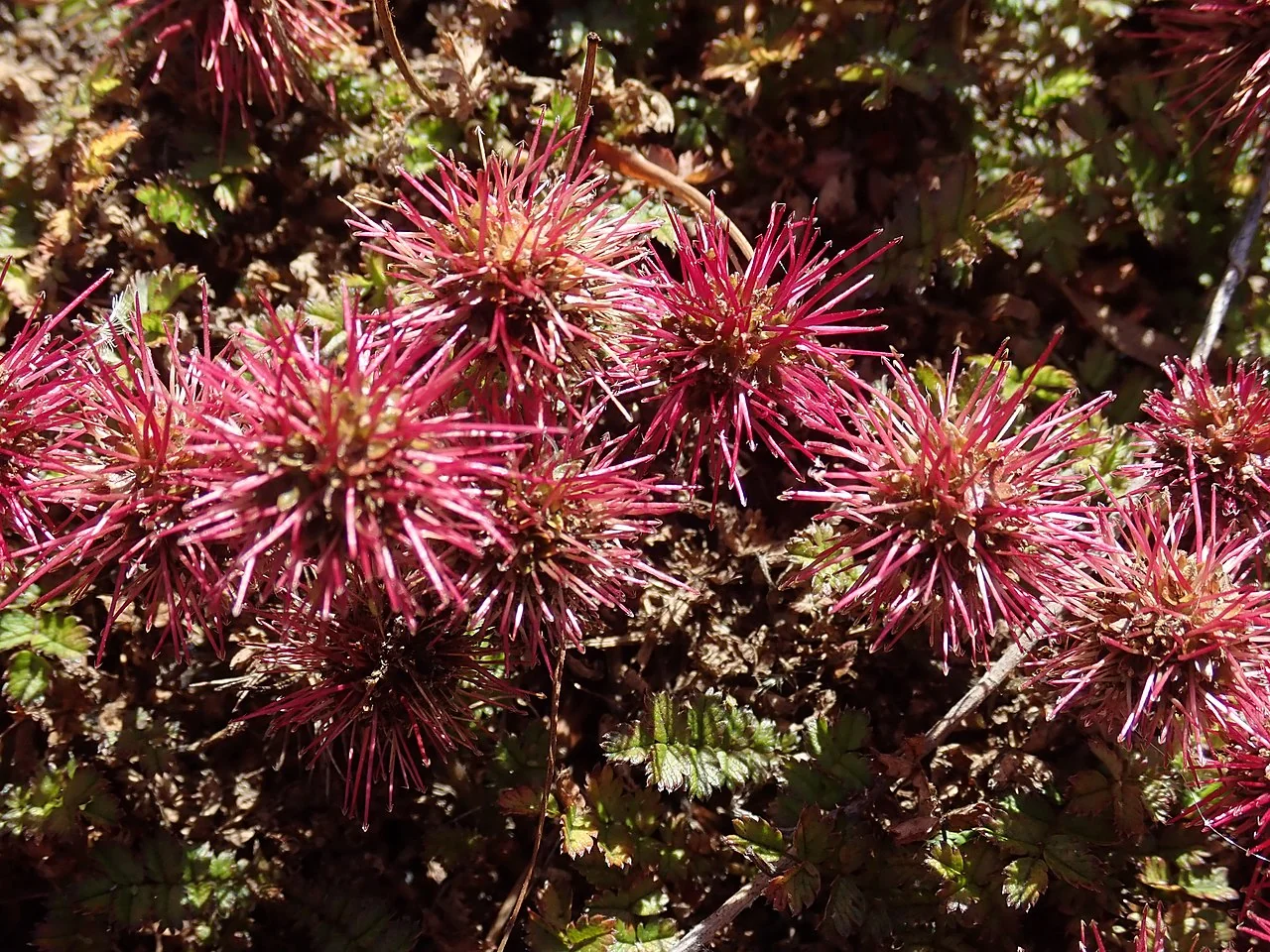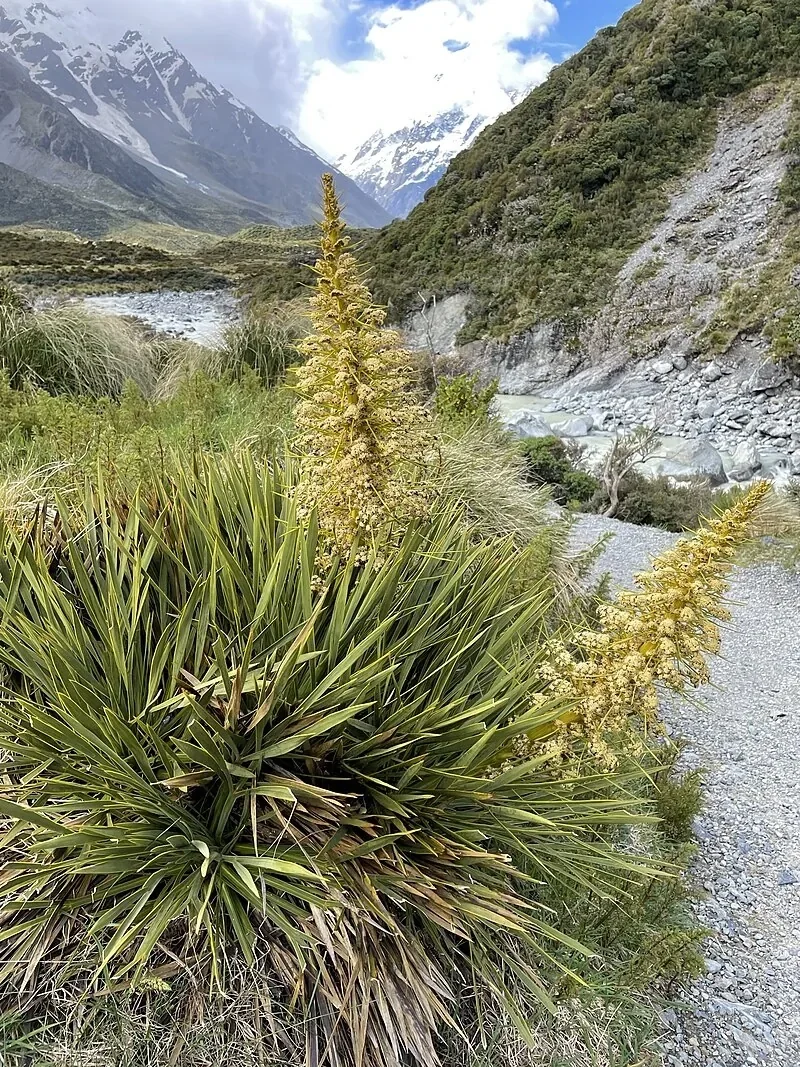
NZ Plantain
Plantago novae-zelandiae
A low, tufting plantain of open, often alpine or subalpine habitats; forms hardy mats with lanceolate leaves. Learn more in our native plants guide .

Plant Description
Botanical Features
NZ Plantain ( Plantago novae-zelandiae ) is a perennial herb endemic to New Zealand, forming small rosettes with a primary root that can be up to 15 mm thick. Each rosette typically has 10 to 40 leaves, which are usually narrowly angular-ovate or angular-ovate, and can be up to 88 mm long (including the petiole) and 19 mm wide. The leaves are often punctate (dotted) and may have isolated hairs or be sparsely hairy on the upper surface, while usually glabrous or with isolated hairs on the lower surface. A distinctive feature is the presence of short (less than 10 mm long), rust-coloured leaf axillary hairs in the basal rosette. The leaves have 1-3 veins, an acute apex, and smooth, wavy, or minutely toothed edges. It produces up to 14 erect inflorescences per rosette, which can reach up to 115 mm in length. The spikes are usually globose or ovoid and contain 2-20 densely crowded flowers. The fruit is a dry, dehiscent capsule, typically broadly ellipsoid or globose, containing 1-4 uniform rust or brown ellipsoid seeds, each 1.3-2.1 mm long. It flowers from November to January and fruits from December to April.
Quick Facts
Overview
| Scientific Name | Plantago Novae Zelandiae |
|---|---|
| Height | 5-15 cm |
| Spread | 30-60 cm |
| Light | Full sun |
| Water Needs | Low-moderate; well-drained soils |
| Frost | Good |
| Frost Tolerance | Hardy once established |
| Salt Tolerance | High; excellent for coastal conditions |
| Growth Rate | Moderate |
| Lifespan | Perennial |
Climate Best Suited to
Regional climate suitability across major New Zealand cities.
Regional Suitability
| Whangārei | Ideal |
| Auckland | Ideal |
| Hamilton | Suitable |
| Rotorua | Suitable |
| Tauranga | Ideal |
| Gisborne | Ideal |
| New Plymouth | Ideal |
| Whanganui | Ideal |
| Palmerston North | Suitable |
| Napier | Ideal |
| Wellington | Ideal |
| Nelson | Ideal |
| Christchurch | Suitable |
| Dunedin | Suitable |
| Invercargill | Suitable |
| City | Climate Suitability |
|---|
Natural Habitat
NZ Plantain ( Plantago novae-zelandiae ) is a perennial herb endemic to New Zealand, found on both the North and South Islands. It thrives in subalpine to alpine environments, specifically in herbfields, grasslands, and scrub, showcasing its adaptation to high-altitude, open habitats.
Preferred Conditions:
- Damp to Wet Areas: This plant is typically found in damp to very wet areas, including bogs, tarns (small mountain lakes), flushes (areas of groundwater seepage), and on rocks or outcrops. This indicates its preference for consistently moist conditions.
- High Altitudes: It grows at elevations ranging from 900 to 1,700 meters (3000 to 5,600 ft) above sea level, highlighting its hardiness and adaptation to cooler, exposed environments.
- Facultative Wetland Species: It is considered a facultative wetland species, meaning it can grow in both wetland and non-wetland conditions, but often specializes in wetland habitats.
Resilience and Adaptability:
- Robust Root System: Its robust root system allows it to endure competitive and dynamic environments, contributing to its survival in challenging alpine conditions.
- Open Habitats: It is a low, tufting plantain of open, often alpine or subalpine habitats, forming hardy mats with lanceolate leaves.
The presence of Plantago novae-zelandiae in these specific habitats underscores its ecological importance in contributing to the biodiversity and stability of New Zealand's unique alpine and subalpine ecosystems.
Plant Conservation
is classified as "Not Threatened" according to the most recent assessment (2022-2023) of the New Zealand Threat Classification System (NZTCS) for plants. This status has been consistent in previous assessments, including those in 2017, 2012, 2009, and 2004. This species, also known as NZ Plantain, is endemic to New Zealand, found in both the North and South Islands. It thrives in subalpine to alpine herbfields, grasslands, and scrub, often in damp to very wet areas like bogs and tarns, at elevations between 900 and 1,700 meters above sea level. Plantago novae-zelandiae
Growing Requirements
Soil
Well-drained, moderately fertile soils; avoid prolonged waterlogging.
Light
Performs in full sun to partial shade depending on species.
Water
Keep evenly moist while establishing; reduce irrigation as roots develop.
Temperature
Hardy in most regions of Aotearoa once established.
For NZ Plantain ( Plantago novae-zelandiae ), choose a site with full sun and soil that is well-drained, moisture-retentive. Incorporate composted organic matter to improve structure and drainage. Plant with the crown or root collar at soil level, then apply a 5-8â¯cm mulch to moderate temperature, conserve moisture, and suppress weeds. Protect young plants from extremes while establishing and consider the stated frost tolerance (seasonal) when siting near exposure or cold air drains.
Planting Guide
NZ Plantain is a unique and hardy native perennial that is well-suited for specialized alpine or rock gardens, as well as for naturalistic plantings in cooler climates. Its low, mat-forming habit and resilience to harsh conditions make it a valuable addition to challenging sites. Proper planting and care will ensure this distinctive plant thrives.
1. Site Selection:
- Sunlight: NZ Plantain prefers full sun. It is adapted to open, exposed habitats and will perform best with ample direct sunlight.
- Soil: It requires well-drained soil. In its natural habitat, it is found in damp to very wet areas, but good drainage is still essential to prevent root rot. It thrives in gritty, rocky, or sandy soils. Incorporating fine grit or sand into the planting area can improve drainage.
- Moisture: While it tolerates damp conditions, it is also remarkably drought-tolerant once established. The key is consistent moisture during establishment without waterlogging.
- Climate and Tolerance: As an alpine species, it is very hardy to frost and cold. It is also tolerant of wind and coastal conditions, making it versatile for various exposed sites.
2. Planting Instructions:
- When to Plant: The best time to plant is in spring or early autumn, allowing the plant to establish its root system before extreme weather conditions.
- Preparation: Dig a hole that is twice the width of the root ball and to the same depth. Gently remove the plant from its container, minimizing root disturbance.
- Placement: Plant at the same level as it was in the container. Backfill the hole with soil, gently firming it around the roots to remove air pockets.
- Watering: Water thoroughly immediately after planting to settle the soil.
- Spacing: For groundcover or mass planting, space plants about 30-50 cm apart to allow them to form a continuous mat.
3. Ongoing Care:
- Watering: Water regularly during the first year to help establish a strong root system. Once established, it is highly drought-tolerant and requires minimal watering, only during prolonged dry spells.
- Mulching: Apply a light layer of gravel mulch around the base of the plant to retain moisture, suppress weeds, and keep the crown dry.
- Fertilizing: A light application of a balanced organic fertilizer in spring can support healthy growth, but avoid overfeeding, as it is adapted to low-nutrient soils.
- Pruning: NZ Plantain requires minimal pruning. Remove any spent flower stalks to tidy the plant and encourage compact growth. Remove any dead or damaged foliage as needed.
- Pests and Diseases: It is generally disease and pest-free. Monitor for any signs of stress or unusual growth.
Ecosystem Notes
- Soil engineer: Rosettes slow runoff and accumulate fines in harsh sites.
- Disturbance-tolerant: Recruits after light disturbance where competition is low.
- Associates: With cushion plants, small grasses, and lichens on gritty soils.
Uses and Significance
Garden and Restoration
A low, tufting plantain of open, often alpine or subalpine habitats; forms hardy mats with lanceolate leaves.
- Rock and alpine gardens
- Ground cover in dry sites
Sow fresh seed of NZ Plantain thinly on a gritty, free-draining mix and keep evenly moist until germination. Prick out into small cells early to develop sturdy root systems and avoid check.
Cultural Significance
Traditional Uses and Values
, also known as NZ Plantain, holds cultural significance primarily due to its traditional medicinal uses by Māori. The leaves of this native plantain were highly valued for their healing properties and were used to treat wounds, cuts, and various skin conditions. This was achieved either by direct application or by preparing healing ointments from the leaves, establishing it as one of the traditional healing plants. Plantago novae-zelandiae
is also considered an example of New Zealand's unique evolutionary history and alpine specialization, representing the country's endemic flora. Its traditional importance contributes to ongoing conservation efforts, which focus on preserving its natural habitats and managing invasive species. Plantago novae-zelandiae The plant's presence in coastal and grassland environments made it readily accessible for traditional medicine, and its distinct appearance aided in its recognition among other native herbs. Beyond its medicinal value,
Landscaping Ideas
Alpine and Dry Garden Rosettes
- Gravel gardens: Dot rosettes between stones for a natural alpine effect.
- Green roof trays: Suitable for shallow, free-draining substrates with full sun.
- Meadow edges: Mix with low native grasses for a resilient, low-water tapestry.
Seasonal Care Calendar
Spring
- Plant and mulch
- Protect new growth from weeds
Summer
- Deep watering in drought
- Monitor pests
Autumn
- Light formative pruning
- Top up mulch
Winter
- Plant eco-sourced stock
- Stake in windy sites
Pruning and Maintenance
Techniques and Timing
Generally minimal; formative work when young and removal of damaged wood.
Prune NZ Plantain lightly to maintain structure; remove damaged shoots and avoid hard cuts on older wood.
How to Grow NZ Plantain
NZ Plantain ( Plantago novae-zelandiae ) is a low, tufted native plantain that establishes readily from seed and can also be divided. It prefers free-draining soils, open sun to light shade, and steady moisture during establishment.
From Seed
Surface sow fresh seed in autumn or spring onto a sterile, free-draining seed-raising mix; do not bury deeply - light aids germination in many Plantago species. Keep evenly moist with a fine mist and provide bright, indirect light at cool to mild temperatures (10-18°C). Germination is often quick under suitable conditions. Prick out seedlings once large enough to handle, and grow on in small pots, avoiding waterlogging. Harden off before planting into the garden.
Division of Clumps
Established clumps can be divided in cool, moist weather (autumn or early spring). Lift the clump gently, tease apart sections with healthy roots and several crowns, and replant divisions at the same depth into free-draining soil. Water well to settle soil around roots and keep evenly moist while new roots establish.
Planting and Establishment
Choose a sunny to lightly shaded site with gritty, well-drained soil. Water regularly through the first season, then reduce as plants establish. Apply a light dressing of balanced, slow-release fertiliser in spring if growth appears weak, but avoid rich, water-retentive media that promote rot. Mulch lightly with gravel to suppress weeds and keep crowns dry. Trim spent flower stalks to tidy and encourage compact growth.
Pests and Diseases
Keep It Lean and Dry
- Crown rot: Overly rich, wet soils cause rot; ensure sharp drainage and avoid overwatering.
- Slugs/snails: May graze young rosettes; use barriers or hand-pick.
- Aphids: Occasional on flower stalks; rinse off or spot-treat.
Bonus Tip
Expert Growing Advice
NZ plantain ( Plantago novae-zelandiae ) is excellent for dry meadow plantings. Cut seed heads when brown and shake into a paper bag - direct sow on open gravel in autumn to spread colonies without disturbing existing rosettes.







